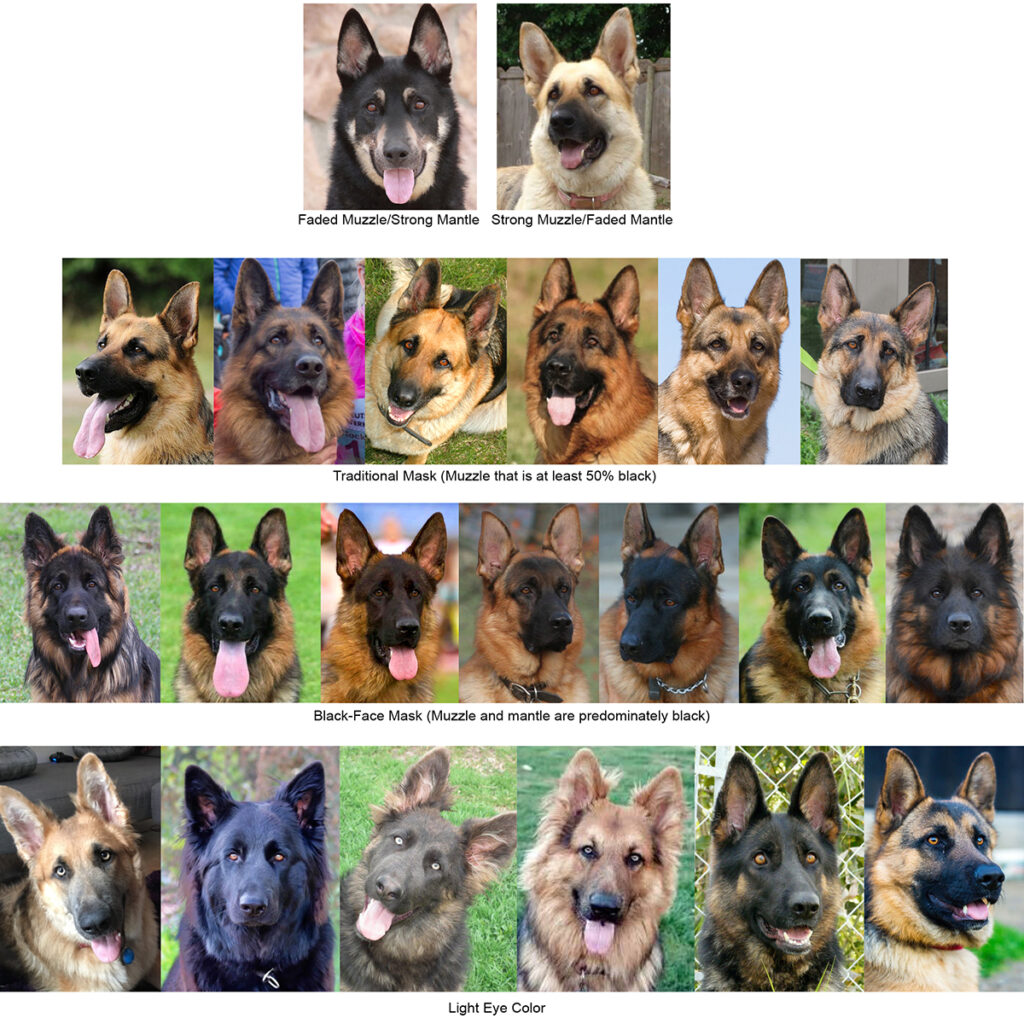
German Shepherd Coat & Color
Coat plays a vital role in the form and function of German Shepherd Dogs. A rich diversity of lengths, colors and pigment—combined with a number of varying body types—make the German Shepherd one of the more structurally diverse of all working breeds. From the short stock coat of the East German working line dogs to the extreme long stock coat of some West German show line dogs—there is a shape, style and color tailored to you and your lifestyle.
There are three main types of hair on German Shepherd Dogs: ground hair (undercoat), guard hair (topcoat) and whiskers. Dogs with both an undercoat and a topcoat are called double coated. The first layer, or undercoat, functions primarily as insulation and is soft and usually of a lighter color. The second layer, or topcoat, consists of thick shafted, coarse hair. This outer coat helps to protect the dog’s skin from abrasions. It also has weatherproofing qualities ideal for working and playing outdoors.
With rare exception, most German Shepherds have double coats—though the degree of undercoat can vary widely. German Shepherds can have little to almost no undercoat or have massively dense, woolly undercoats that require daily maintenance. Double coats are ideal for maintaining warmth in colder months, but also provide cooling in the summer by keeping heat away from the surface of the skin. For this reason, the shaving of double-coated dogs is not recommended if they have prolonged exposure to the elements. Their coat helps regulate body temperature and protects their skin from harmful UV rays.

Shedding
German Shepherds, aka German Shedders, shed and shed a lot. Working dogs are required to do their jobs regardless of weather or terrain. To keep their coats in optimum condition—daily, excessive shedding is needed. Unfortunately for us, this means additional brushing and bathing. If you do not own a good vacuum cleaner or sweeper, you will need to purchase one if you have one or more German Shepherds inside your home.
How Often Do German Shepherds Shed?
German Shepherds shed year around and “blow” their coats twice annually. In the spring, their thick winter undercoat is shed and replaced with a thinner, cooler undercoat. In the fall, their summer undercoat is shed and replaced by a thicker, warmer undercoat.
Care and Grooming
Daily brushing and frequent bathing are your best defenses against excessive shedding. Bathe and groom puppies frequently so they learn to enjoy—or at least tolerate—the experience. Most German Shepherds enjoy a good grooming and since most love water (in any form), bathing can also be a pleasurable experience for them.
Brushing
Most double-coated breeds like German Shepherds need to be brushed regularly—especially if they have a thick undercoat. In the spring and fall when their coats are being blown, daily brushing is important. This helps reduce the amount of hair inside your home and removes their undercoat more quickly. While regular brushing is great for removing loose and dying hair, it also gets rid of mats and tangles—which are common with long- and medium-length coats. Mats are not only unsightly, but they can be painful due to their closeness and tightness to the skin. In southern parts of the country where humidity is high, mats can also lead to skin irritations as the dampness can encourage the growth of skin irritants and other microbes. Check your German Shepherd often for mats—paying special attention to areas behind the ears, between the legs and along the back of the thighs. If your dog is a short stock coat with little undercoat, occasional brushing and bathing is all that is required to keep their coats looking great.
Daily brushing and frequent bathing are your best defenses against excessive shedding.
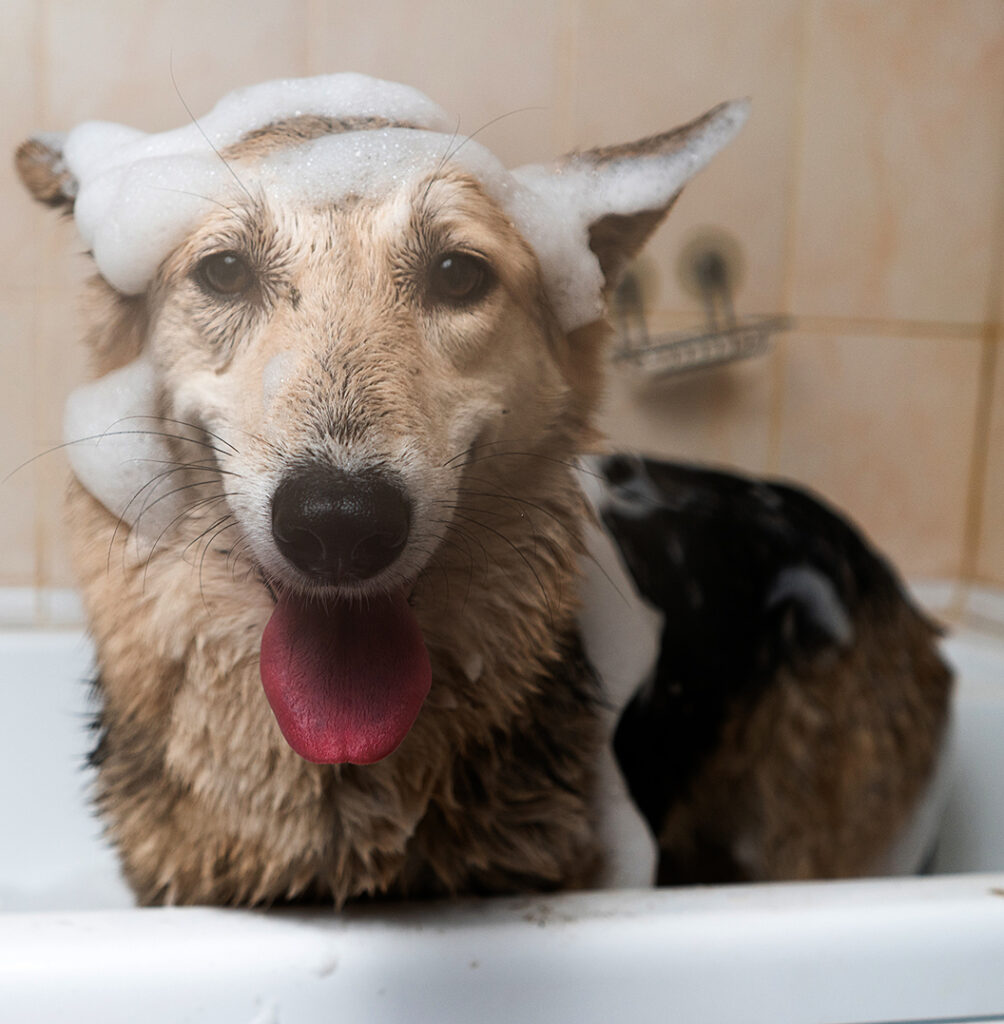
Bathing
Bathing can help rid your German Shepherd of a lot of shedding hair. The trick is to use a deshedding shampoo and conditioner to help slick down hairs and make them easier to remove.
After their bath, while they’re still a little bit damp, brush out their entire coat. The slicked down hairs will dislodge much easier and can help to greatly reduce shedding.
How Often Should German Shepherds Be Bathed?
Bathing too often can strip your German Shepherd’s coat of its natural oils and can lead to dry, irritated skin. It is recommended that you bathe your dog approximately once every 8 weeks or so.
Of course, other factors can come into play. If your dog goes outside often, you may want to bathe them more frequently. If your German Shepherd smells, this is another indicator that it’s time for a bath. How often you brush your German Shepherd’s fur can also have an effect on how often you have to bathe them. Regular brushing is important because it prevents dirt and other debris from getting trapped in your dog’s fur, and helps to keep their coat looking great.
COAT LENGTH
Short Stock Coat (1″ long or less)
Short stock coats are ideal for working environments as these coats don’t get tangled or matted or pick up debris while in the field. They also don’t obstruct the dog’s vision or impair movement while working. This short coat, with a thin undercoat, is easy to maintain and can require little or infrequent grooming. Bathing is a breeze as their coats are designed for waterproofing and dry quickly. Water generally rolls off of the guard hairs of German Shepherd Dogs. For all of these reasons and more, short stock coats are the preferred coat type for service dogs, police dogs and military dogs.
The dog pictured to the right is an excellent example of a very nice, healthy coated, short stock coat—with minimal undercoat.
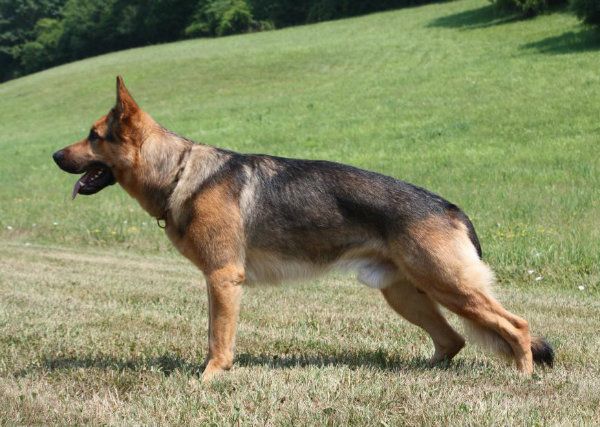

Medium Stock Coat “Plush” (1″ to 2″ long)
Somewhere in between short stock coated dog and the long stock coated dogs lies the medium stock coat or “plush” coat. This medium stock coat is most preferred by the American Kennel Club (AKC) standards and is now appearing more frequently inWest German show rings. Medium stock coats have longer, thicker hair on the neck, underbelly and along the back of the thighs. Their undercoat tends to be more dense than that seen in the short stock coats of West and East German working lines. Additionally, these dogs do not have the traditional “ear fuzzies” commonly seen on the long stock coated dogs. Medium stock coats require additional grooming to keep their coats in optimum condition. Note also that medium- and long-coated dogs do not shed more than their short stock coat counterparts—the hair shed is just longer.
Long Stock Coat (2″ or longer)
Long stock coat German Shepherds have thick, soft undercoats and silky guard hair that is two inches or longer on the body. Hair around the face, ears, chest, bottom line and back of thigh (panties) can exceed four inches in length. This coat requires regular care and grooming. Hair, especially behind the ears and between their rear legs, is prone to matting, and requires daily brushing. The American Kennel Club (AKC) is one of the few show organizations that still consider a long stock coat to be faulty. Long stock coat dogs are not only accepted by most German Shepherd Club organizations, including the German SV, but they have become valuable and sought after in recent years—and compete at the highest levels in Germany and worldwide. Note also that these coats often continue to grow in length and density with age, so older dogs require daily care and grooming.
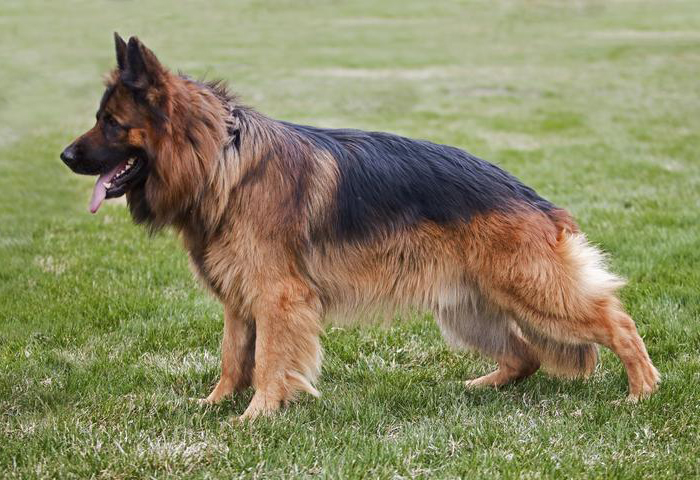
All coat colors and lengths mentioned above are attributes of purebred German Shepherds. However, some breed organizations consider certain characteristics to be breed faults and can be penalized or even disqualifying in the show ring. As an example, the American Kennel Club (AKC) doesn’t recognize white dogs and they consider a long stock coat to be faulty. If you are getting a German Shepherd as a companion and pet, these “faults” have no bearing on your decision as to which line of German Shepherd to consider. However, if you plan to breed or show your dog, you will need to study the standard and requirements of your desired show organization(s) to ensure your dog is eligible to compete.
German Shepherd Coat Lengths
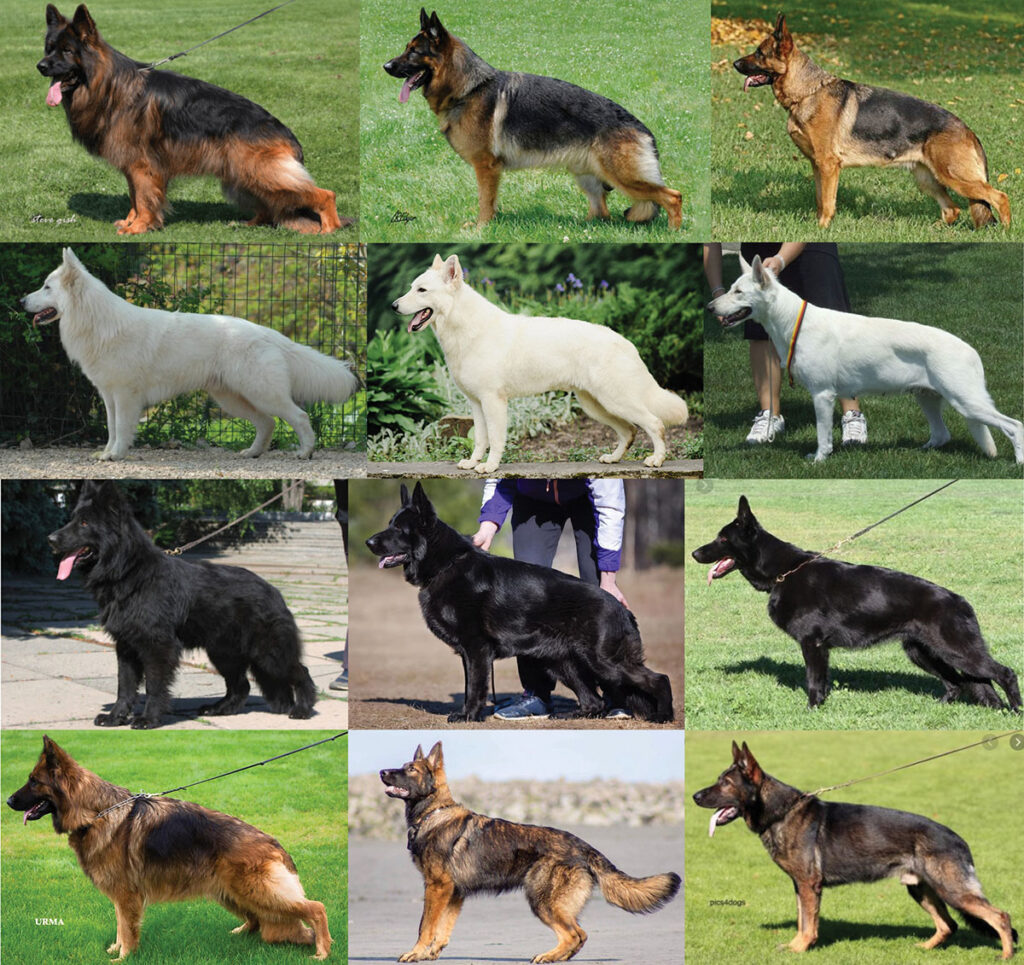
COAT COLORS
When most people think of German Shepherds, an image of the typical black and tan dog from the movies comes to mind. But the German Shepherd of today actually come in a much larger variety of colors and patterns. The color of their coat is dictated by genes. Genes that are dominant are more common, while genes that are recessive are more rare. Some colors are considered faults and are not recognized by the AKC.
Black and Tan
This is the most common color pattern—which is usually black all over, with tan or cream-colored chest and legs. They also have their accent color extending from their neck to their tails and underneath their bellies. There are many color variations of this pattern, most commonly: black and red, black and cream, and black and silver.
Bicolor
Another variation to the traditional black and tan colored dog are bicolored dogs. Bi-colored German Shepherds have a band of black color running down the forelegs (often in a “V” shape) and on the backs of their hocks. Their bodies are predominantly black with a secondary accent color on the lower legs of tan, cream, gray/silver. All of these black areas (also called points) on the legs and toes should be richly pigmented. A dog is not considered to be bi-colored unless it has these distinctive black markings and they can appear on both dual and sable patterned dogs.
Sable
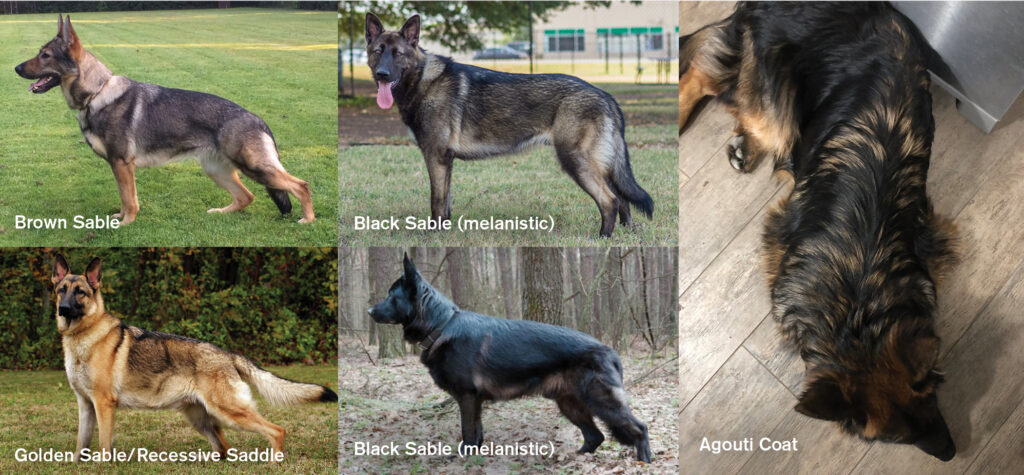
No good dog is a bad color.
– Max von Stephanitz, German Shepherd breed founder
Solid Black
Black German shepherds are born black and remain that way through adulthood, sometimes sporting a white spot or “blaze” on their chest or toes. Like white German Shepherd’s, the black dog’s color is caused by a recessive gene that can be carried by any colored dog. Black is uncommon (due to being a recessive gene) but still prevalent within the breed. Typically they are completely black with no other colors on their body.
Solid White
White German Shepherds are not albinos; their color is the result of a recessive gene that can be carried by any colored dog. When learning about pigment and color patterns, understand that white is not a color. There is no solid color gene for white. A white gene is actually a masking gene that covers up or hides a dog’s true color and pattern. The more pure white a dog, the lighter the color of its masked color. The more buff or cream visible, the darker the underlying masked color. Every white German Shepherd is really a traditional color and pattern under a white mask.
Blue
Blue German shepherds are thought to have resulted from dilution of the color black in the dog’s genes. The blue colors in these dogs replace the black areas of their more common black-and-tan counterparts. Blue dogs often appear as a dusty or somewhat light grey with a grey leather nose. Sometimes these puppies are born with very light eyes as well. This, too, is a rare recessive gene and considered a faulty color by AKC.
Isabella
An Isabella German Shepherd, aka lilac or mouse-gray German Shepherd, is the result of a recessive gene dilution giving them a washed-out silvery-blue color. The color is not technically a blue, however. The color is most widely recognized within the Weimaraner breed. Because Isabella German Shepherds are a less common and considered faulty for showing purposes, there are fewer reputable and responsible breeders. Select your Isabella GSD breeder carefully and insist on thorough health testing information and lineage information.
Liver
Liver is another recessive gene leading to liver-colored offspring. In a liver-colored dog, all the black parts are a brown or liver color, ranging from light to dark shades. They may also have light eyes, which typically changes into a darker color with age.
Panda
The origin of the Panda Shepherd is highly debated and there is no shortage of controversy surrounding the breed. New research however confirms that this pattern was not the result of crossbreeding—but rather a genetic mutation. The original Pandas were DNA tested and are in fact, purebred German Shepherds. The very unique looking piebald pattern has white on at least 30% of its body, mixed with patches of black and brown.
Ticking vs. Roan vs. Blue Merle
Ticking is flecks or spots of color on white areas. Most ticked dogs are born white and develop ticking as they mature. Generally, ticking is heaviest on the legs and muzzle.
Roan is a pattern of white and colored hairs evenly mixed over the white areas of the body. Roaning creates a near-solid pattern over a white coat causing a dog to appear dusted with white. If the predominant color of the dog is black, then the roaning can appear bluish in color.
Merle is a solid base color, usually red/brown or black, with lighter blue/gray or reddish patches, which gives a mottled or uneven speckled effect. People sometimes confuse merle dogs with roan or ticked dogs. Merle dogs do not have a white base coat of color, however, some merle dogs are ticked.
The genes responsible for ticking, roaning and merle are dominant so no purebred German Shepherd can produce these patterns of color.

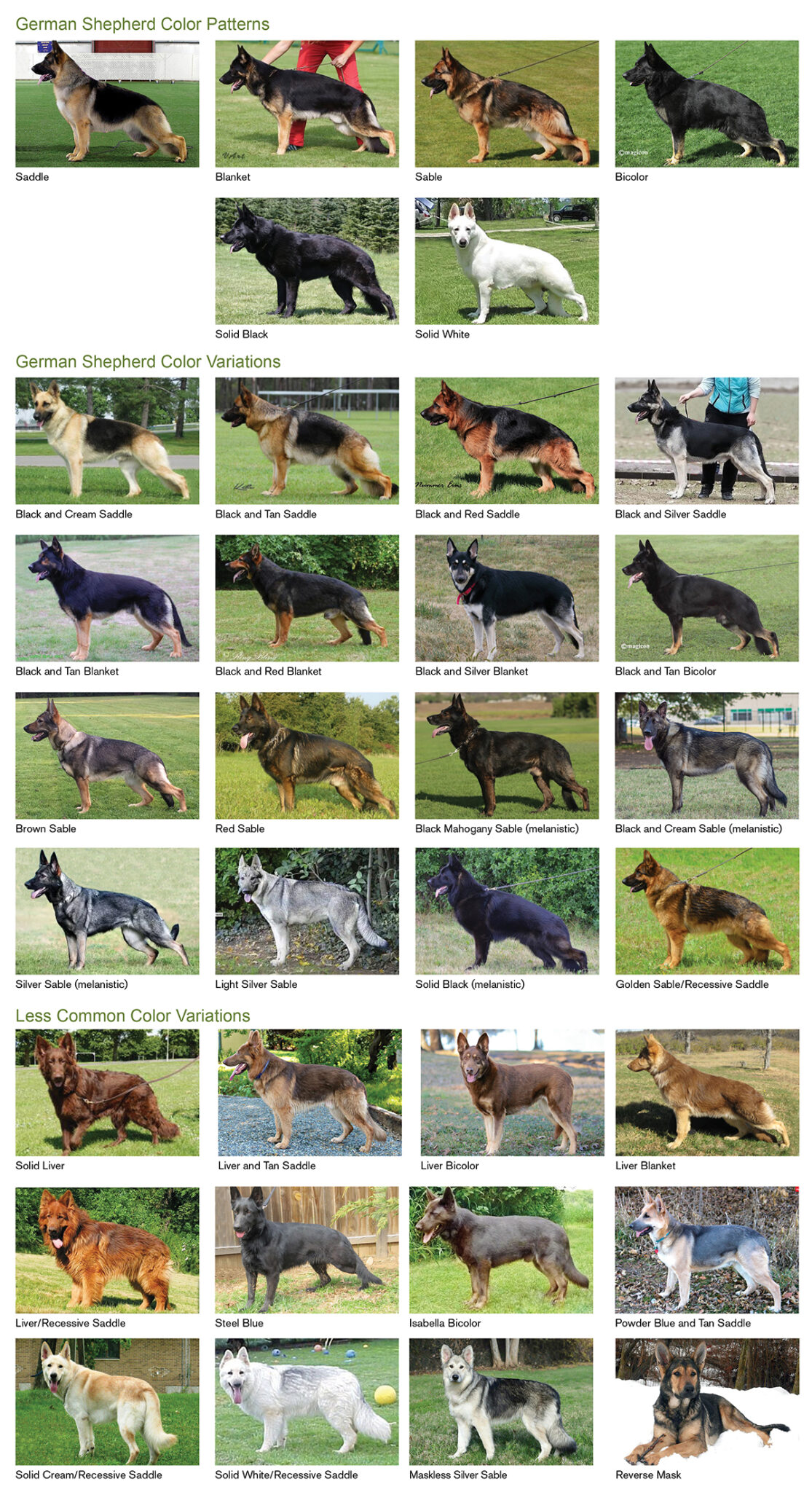
German Shepherd Coat Colors – Fault or Fancy?
As we can see from the images above, German Shepherds come in an array of coat colors and patterns—including saddle, blanket, bicolor, sable and solid colors. In keeping with the breed founder’s philosophy of color not affecting the working ability of any good working dog, no pure-bred German Shepherd Dog can be denied registration based on color—with one exception, the Panda. (Panda is discussed below.) This means less common coat colors and patterns such as white, liver, blue and Isabella can all be registered with the AKC. The organization does not, however, allow dogs of these colors to be shown in the conformation ring as these characteristics are faults according to the German Shepherd breed standard. Dogs carrying the liver gene or the recessive dilution gene that produces either Isabella or blue dogs also carry serious penalties in the show ring.
The Federation Cynologique Internationale (FCI) (or World Canine Organization) is an international federation of a number of national kennel clubs. The FCI’s International Standard of the GSD, the only standard approved by the WUSV (World Union of GSD Clubs), requires every German Shepherd to be black on top and have black leathers (eye rims, nose, lips, pads). Liver, blue and Isabella are not recognized because of the color of their leathers; and the solid whites are omitted due to the absence of black in the hairs on top of their backs.
World wide, the breakdown for colored GSDs is approximately:
73% saddle
15% sable
9% bicolor
3% solid black
German Shepherd Dogs of less common colors and patterns are still pure-bred German Shepherds and if these dogs are to live their lives as working dogs and/or companion animals, color is of no consequence. If you wish to campaign and show your dog in the conformation ring, however, you will need to keep with animals with traditionally accepted colors and patterns.
Of all German Shepherds registered with the American Kennel Club (AKC), approximately 93% are standard colors (saddle, sable, bicolor and solid black); 5% solid white; and less than 2% off colors (liver, blue and Isabella).
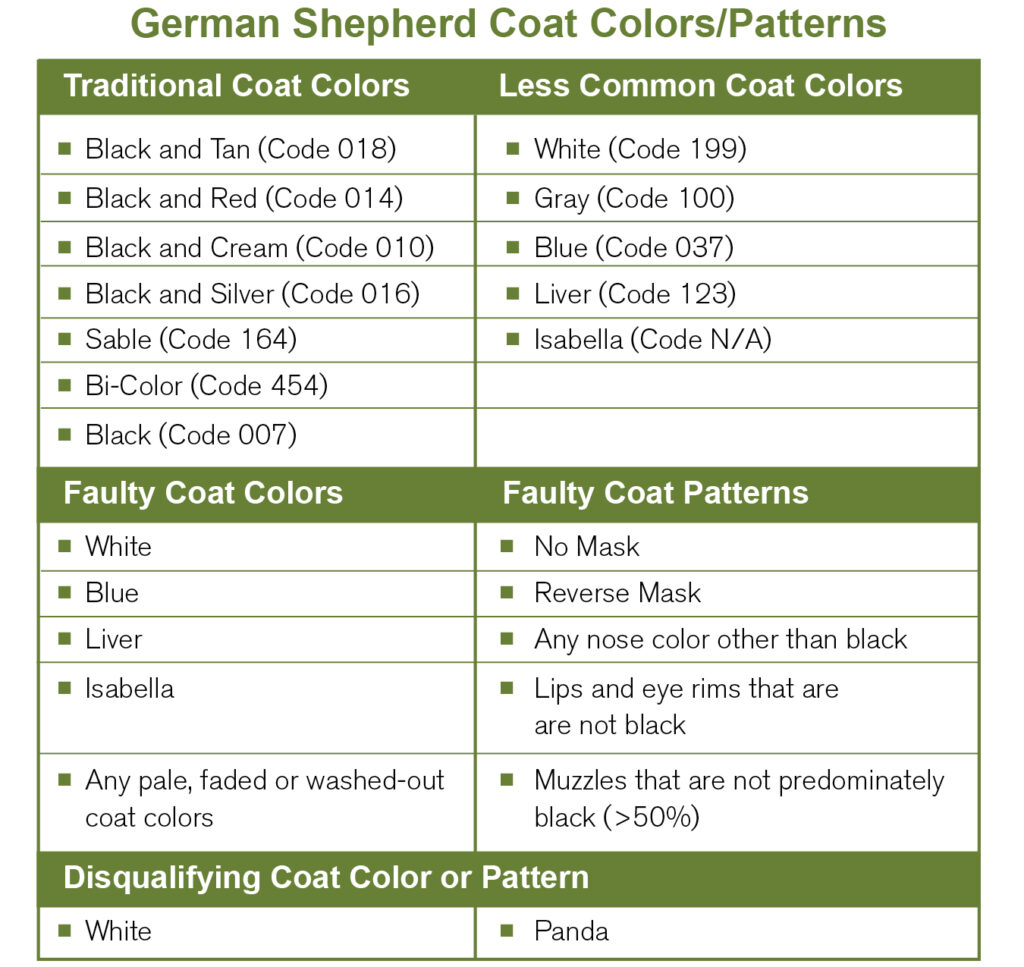

White German Shepherds are a disqualifying color according to the American Kennel Club (AKC), German Shepherd Dog Club of America (GSDCA) and the Verein für deutsche Schäferhunde (SV) breed standards. Dogs that are liver, blue or Isabella are severely penalized. Panda German Shepherds are not permissible by any of the above organizations, but they can be registered with AKC if DNA tested.
Panda German Shepherd
A Panda Shepherd is a piebald German Shepherd that appeared as a genetic mutation in a single GSD line in 2000. The dog is 35% white with the rest rest of the body black and tan in color. It was a spontaneous mutation and has no White German Shepherds in its ancestry. Panda are the same height and weight of standard German Shepherds and stand between 24-26 inches and weigh 75-95 lbs. This breed is NOT recognized by AKC or any other major kennel club but can be registered as a German Shepherd with AKC if DNA tested. Like White dogs, Pandas cannot show in the conformation ring due to their coloring.
Reverse Mask and Maskless German Shepherds
The reverse mask (aka wolf mask) German shepherd is not a mix or hybrid, but rather a dog presenting a pattern that appears when both parents carry the gene for this coloring. These patterns date back to some of the earliest German Shepherd foundation dogs and still appear in certain lines, today. London, The Littlest Hobo, was a great example of one of the famous reverse-mask German Shepherds. Rin-Tin-Tin was was another reverse-mask (without the stripe) German Shepherd.
The reverse mask can also present with or without the wolf stripe running down the nose. Some dogs are born with the wolf stripe but it fades with maturity—while others maintain the stripe.
Maskless German Shepherds are dogs born with no mask, meaning their face coloring is the same as that of their body. Maskless dogs most commonly present as solid cream, tan, gray or silver.
Both reverse mask and maskless German Shepherds are considered faulty (lacking pigment) for conformation purposes.
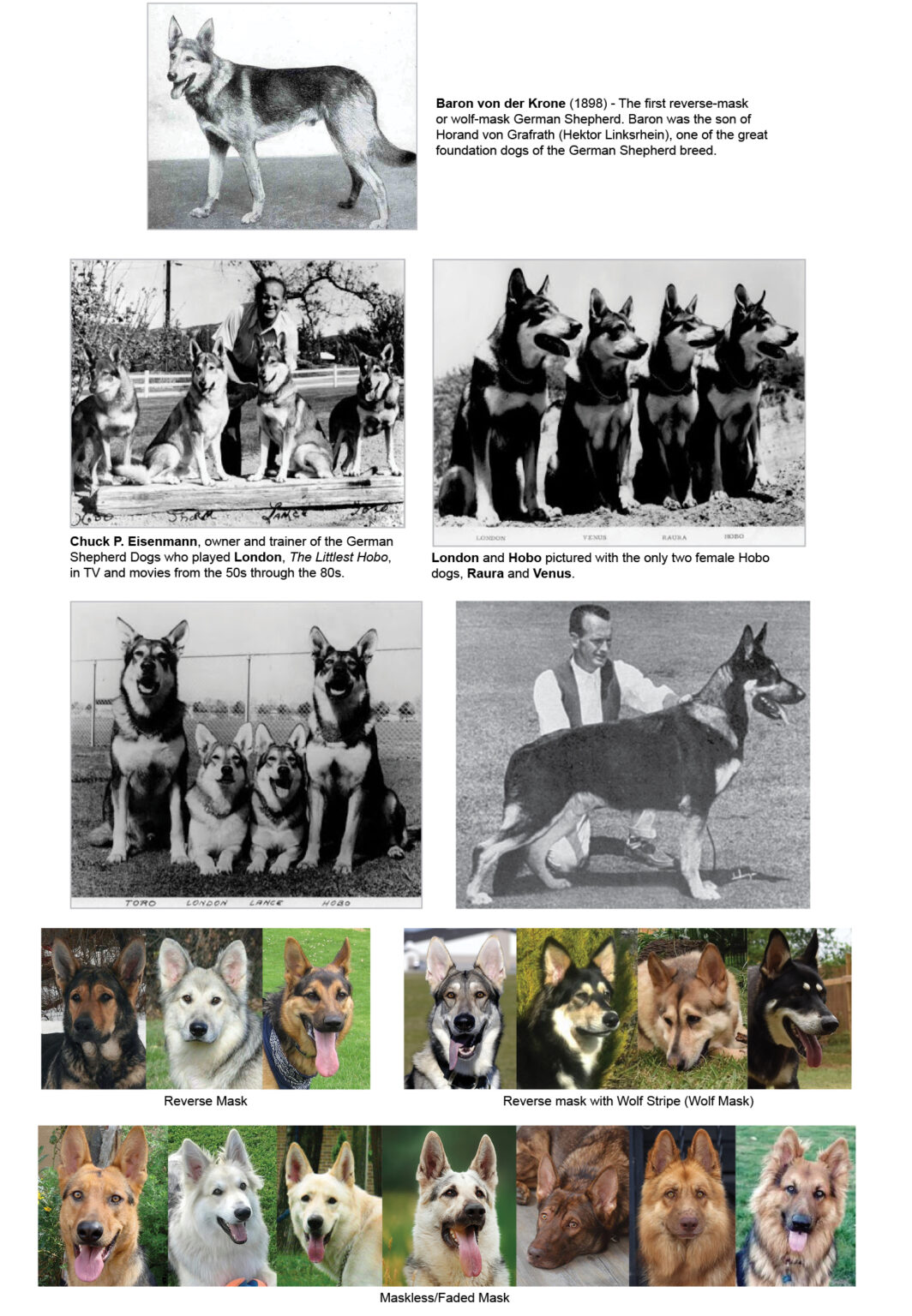
Impression and Expression
Impression – an idea, feeling, or opinion about a dog formed without conscious thought—or formed on the basis of little information.
“The first impression of a good German Shepherd Dog is that of a strong, agile, well muscled animal, alert and full of life. It is well balanced,
with harmonious development of the forequarter and hindquarter. It looks substantial, giving the impression—both at rest and in motion—of muscular fitness and nimbleness. The ideal dog is stamped with a look of quality and nobility–difficult to define, but unmistakable when present.”
Expression – the emotion conveyed when looking at a dog’s face.
Aside from overall outline, size and strength of body, the head is the most prominent feature of a German Shepherd. It is here that we find expression. The head should convey strength of character, intelligence, confidence and nobility—even in the very young.
In recent years, some show lines have developed a black-face mask in which the entire mantle and muzzle of the dog is predominately black. Any feature that detracts from the overall impression or expression of a dog can be less desirable. Black-faced German Shepherds have become very popular, but some traditionalists believe this pattern does, in fact, change the expression of the dog—giving it an intimidating or less approachable expression. Another example of how color can impact expression is eye color. Light eyes on a German Shepherd overpower other aspects of the dog and change its expression from that of a traditional, loyal shepherd to that of a more elusive, mystic wolf. The dog’s strongest feature becomes its eyes—dramatically shifting its overall expression away from the standard. For this reason, the breed standard calls for the eyes of German Shepherds to be as dark as possible. In the show ring, light eye color—especially yellow hues—are penalized.
